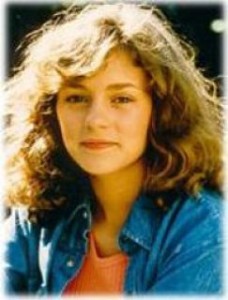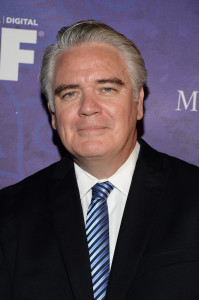Long before a certain Goth adventuress ever made her literary debut in my young adult novel Blood Feud: The Saga of Pandora Zwieback, Book 1, there was teenager Amanda Waters, the lead character in The Mysterious Mr. Peabody, a shot-on-video student film that I wrote and directed during my last year of college, back in 1984. Running about fifteen minutes, it was about a girl who suspects that her science teacher has a strange secret and, doing her best Nancy Drew imitation, goes forth to find out what it is. Spoiler: He’s an alien!
Hmmm. A smart, inquisitive teenaged girl who finds herself drawn into the beginning of a weird adventure—now where might I have seen that most recently…in book form? 😉 So, yeah, you could say that Pan and Amanda are distant cousins, or that Amanda was the template from which I constructed Pan—after all, between Mr. Peabody and Blood Feud I didn’t do a whole lot of writing (as in, any) involving young adult characters.
Mr. Peabody (the name borrowed from my high school science teacher, not the time-traveling cartoon dog) was my final student project for a television production class at New York University. The class was taught by George Heinemann, a former NBC executive who’d developed children’s educational programs in the fifties and sixties, and whose work (weirdly coincidental) won multiple Peabody Awards for television excellence. Heinemann taught us students the steps required in creating a show by having us work in NYU’s video-production studios—there we learned how to use the massive studio cameras (the kind that roll across the floor); how to use the control room’s sound and video boards; and how to direct. Then he turned us loose to create our own projects, so that we’d have hands-on experience with all aspects of production—for example, on Jane’s project I might be one of the camera operators, but for Tom’s I’d be working the sound board, and for Jerry’s I’d be handling the video board.
 For Mr. Peabody, I wrote the script, drew the storyboards, and directed the in-studio segments from the control room—but then I had to go and complicate things by wanting to shoot at other locations: an office for a scene involving computers, and a couple scenes in which characters walked down city streets. And that involved lugging around video-recording equipment like the Sony setup you see here (courtesy of Wikipedia); that’s right, it had a separate tape deck—and worse, the tapes were Betamax, the small, boxy precursor to VHS that became obsolete as soon as VHS was accepted as the standard format for videotapes. Schlepping around a camera, a tape deck, and a tripod was a major pain in the butt—especially because my weekend shoots meant no one from the class was available to help out—but, y’know, that’s how we did things back in the days of the dinosaurs. (You kids, with your cell-phone cameras and tiny recorders and the like—you’ve got it easy!) But what did I care—I was too wired on coffee and lack of sleep to be slowed down by things like hauling equipment. Nothing was gonna stop me!
For Mr. Peabody, I wrote the script, drew the storyboards, and directed the in-studio segments from the control room—but then I had to go and complicate things by wanting to shoot at other locations: an office for a scene involving computers, and a couple scenes in which characters walked down city streets. And that involved lugging around video-recording equipment like the Sony setup you see here (courtesy of Wikipedia); that’s right, it had a separate tape deck—and worse, the tapes were Betamax, the small, boxy precursor to VHS that became obsolete as soon as VHS was accepted as the standard format for videotapes. Schlepping around a camera, a tape deck, and a tripod was a major pain in the butt—especially because my weekend shoots meant no one from the class was available to help out—but, y’know, that’s how we did things back in the days of the dinosaurs. (You kids, with your cell-phone cameras and tiny recorders and the like—you’ve got it easy!) But what did I care—I was too wired on coffee and lack of sleep to be slowed down by things like hauling equipment. Nothing was gonna stop me!
It was shot over the course of a month, if I remember correctly, since I had to work around the unpaid cast’s schedule, and then sit with my video editor to put the whole thing together. But when the final product was shown to the cast and “crew,” I was overjoyed. Having watched it again recently—I had the “master” Beta edit transferred to a DVD—I can laugh and cringe at what it looks like, thirty-one years later, but I’m still happy with what I accomplished.
Other than its historical value—in terms of its tiny influence on the creation of Pan Zwieback, fourteen years later—the short features a pair of actors Heinemann introduced me to, who went on to successful careers:
 Lucy Deakins, who played Amanda, is best remembered for her role in the 1986 cult film The Boy Who Could Fly, but she also appeared—according to her Internet Movie DataBase page—in the comedy The Great Outdoors (starring John Candy and Dan Aykroyd), the movies Cheetah and There Goes My Baby, an ABC Afterschool Special in which she sued a boy for standing her up on a date, and a couple of episodes of Law & Order. She left the acting profession in 2002 and became an attorney (well, that involves a bit of acting, too, doesn’t it?). Lucy also made a terrific Amanda Waters, too.
Lucy Deakins, who played Amanda, is best remembered for her role in the 1986 cult film The Boy Who Could Fly, but she also appeared—according to her Internet Movie DataBase page—in the comedy The Great Outdoors (starring John Candy and Dan Aykroyd), the movies Cheetah and There Goes My Baby, an ABC Afterschool Special in which she sued a boy for standing her up on a date, and a couple of episodes of Law & Order. She left the acting profession in 2002 and became an attorney (well, that involves a bit of acting, too, doesn’t it?). Lucy also made a terrific Amanda Waters, too.
 Michael J. Harney (seen here in a recent picture) played Amanda’s father. You recognize him, don’t you? He’s one of those famous “I know you, you’re that guy whose name I can’t remember” character actors you’ve seen in dozens of movies and television episodes. Michael’s sort of made a career of playing law-enforcement types over the decades, mostly as detectives in shows like Law & Order, NYPD Blue, and Without a Trace; he also played Xander’s father in an episode of Buffy the Vampire Slayer. Two of his most recent high-profile appearances have been as a supporting character on the first season of HBO’s megapopular series True Detective (starring Matthew McConaghey and Woody Harrelson); and in a recurring role on Netflix’s Orange Is the New Black.
Michael J. Harney (seen here in a recent picture) played Amanda’s father. You recognize him, don’t you? He’s one of those famous “I know you, you’re that guy whose name I can’t remember” character actors you’ve seen in dozens of movies and television episodes. Michael’s sort of made a career of playing law-enforcement types over the decades, mostly as detectives in shows like Law & Order, NYPD Blue, and Without a Trace; he also played Xander’s father in an episode of Buffy the Vampire Slayer. Two of his most recent high-profile appearances have been as a supporting character on the first season of HBO’s megapopular series True Detective (starring Matthew McConaghey and Woody Harrelson); and in a recurring role on Netflix’s Orange Is the New Black.
Special note for literary historians: This short film about a student and her alien school teacher predated author Bruce Coville’s bestselling middle-grade series My Teacher Is an Alien by five years. (Oddly enough, the series was co-created and packaged by Byron Preiss, the very same publisher for whom I worked as a fiction editor ten years after The Mysterious Mr. Peabody was shot. Talk about coincides!)
Oh, and by the way, since I was there first, I believe you owe me some royalties, Bruce… 😉

Pingback: A Note on Pre-Zwiebackian History | StarWarp Concepts